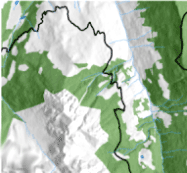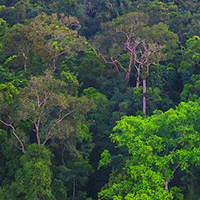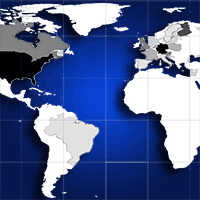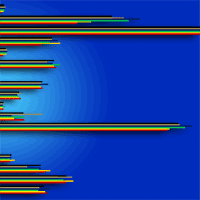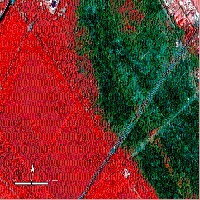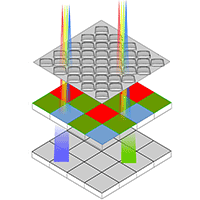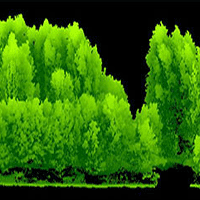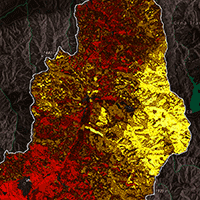
Assessment of land sensitivity to degradation using MEDALUS model - a case study of Grdelica Gorge and Vranjska Valley (southeastern Serbia)
Sara Lukić (1) , Aleksandar Baumgertel (1), Snežana Obradović (2), Ratko Kadović (1), Jelena Beloica (1), Damjan Pantić (2), Predrag Miljković (1), Snežana Belanović Simić (1)
iForest - Biogeosciences and Forestry, Volume 15, Issue 3, Pages 163-170 (2022)
doi: https://doi.org/10.3832/ifor3871-015
Published: May 07, 2022 - Copyright © 2022 SISEF
Research Articles
Abstract
Land degradation is a complex issue caused by diverse drivers, each of which should be considered in the analysis of land sensitivity to degradation. This study identifies the areas most sensitive to land degradation in the Grdelica Gorge and Vranjska Valley, which are unique in terms of natural and socioeconomic conditions. Land-use changes and inappropriate land management have led to serious degradation in this region. The flexible and multifactorial approach of the Mediterranean Desertification and Land Use (MEDALUS) model allowed comprehensive land degradation sensitivity analysis in the study area. The main factors driving soil degradation were assessed by estimating climate quality index, soil quality index, and vegetation quality index, and the main socioeconomic indicators by management quality index and social quality index. The results showed that forest cover is the main factor to contrast land degradation, and even minor adverse changes in forest characteristics, such as structure, canopy cover, health, and quality, could trigger degradation processes. The vegetation quality index was defined in terms of the current vegetation’s capacity to protect soil from erosion, drought resistance, and fire risk. Detailed data on forest vegetation cover was obtained from the National Forest Inventory (NFI). The environmentally sensitive area (ESA) index generated through the analysis classified 26.11% of the total study area as critical, 69.53% as fragile, and 2.70% as either prone to or unaffected by degradation processes. According to the ESA index, the areas covered by forests with optimal species composition and high canopy cover were the least susceptible to degradation. The areas under intensive agricultural production without any application of conservation measures were the most susceptible to degradation. Future strategies for optimal land-use patterns are discussed, such as the intergration of woody species in croplands to protect soil against degradation and meet human needs in the areas prone to degradation.
Keywords
Land Degradation, Sensitivity, MEDALUS, Vegetation Cover, Spatial Analysis
Authors’ Info
Authors’ address
Aleksandar Baumgertel 0000-0002-8448-0261
Ratko Kadović 0000-0002-3948-6066
Jelena Beloica 0000-0003-4135-1002
Predrag Miljković 0000-0001-6060-4349
Snežana Belanović Simić 0000-0003-0962-5595
Department of Ecological Engineering for Soil and Water Resources Protection, University of Belgrade, Faculty of Forestry (Serbia)
Damjan Pantić
Department of Forestry, University of Belgrade, Faculty of Forestry (Serbia)
Corresponding author
Paper Info
Citation
Lukić S, Baumgertel A, Obradović S, Kadović R, Beloica J, Pantić D, Miljković P, Belanović Simić S (2022). Assessment of land sensitivity to degradation using MEDALUS model - a case study of Grdelica Gorge and Vranjska Valley (southeastern Serbia). iForest 15: 163-170. - doi: 10.3832/ifor3871-015
Academic Editor
Agostino Ferrara
Paper history
Received: May 12, 2021
Accepted: Feb 21, 2022
First online: May 07, 2022
Publication Date: Jun 30, 2022
Publication Time: 2.50 months
Copyright Information
© SISEF - The Italian Society of Silviculture and Forest Ecology 2022
Open Access
This article is distributed under the terms of the Creative Commons Attribution-Non Commercial 4.0 International (https://creativecommons.org/licenses/by-nc/4.0/), which permits unrestricted use, distribution, and reproduction in any medium, provided you give appropriate credit to the original author(s) and the source, provide a link to the Creative Commons license, and indicate if changes were made.
Web Metrics
Breakdown by View Type
Article Usage
Total Article Views: 33245
(from publication date up to now)
Breakdown by View Type
HTML Page Views: 27291
Abstract Page Views: 3591
PDF Downloads: 1887
Citation/Reference Downloads: 7
XML Downloads: 469
Web Metrics
Days since publication: 1340
Overall contacts: 33245
Avg. contacts per week: 173.67
Citation Metrics
Article Citations
Article citations are based on data periodically collected from the Clarivate Web of Science web site
(last update: Mar 2025)
Total number of cites (since 2022): 5
Average cites per year: 1.25
Publication Metrics
by Dimensions ©
Articles citing this article
List of the papers citing this article based on CrossRef Cited-by.
References
Assessment and mapping the sensitive areas to desertification in an insular Sahelian mountain region - Case study of the Ribeira Seca Watershed, Santiago Island, Cabo Verde. Catena 128: 214-223.
CrossRef | Gscholar
Resistance to the reclamation of environmentally sensitive areas through the establishment of a new forest ecosystem. Fresenius Environmental Bulletin 24: 1195-1203.
Gscholar
Vodna i eolska erozija zemljišta [Water and wind soil erosion]. Acta Biologica Jugoslavica, Belgrade, Serbia, pp. 440. [in Serbian]
Gscholar
Evaluation and selection of indicators for land degradation and desertification monitoring: methodological approach. Environmental Management 54: 951-970.
CrossRef | Gscholar
The MEDALUS project - Mediterranean desertification and land use: manual on key indicators of desertification and mapping environmentally sensitive areas to desertification. Project ENV4 CT 95 0119, Directorate-General Science, Research and Development, Brussels, Belgium, pp. 88.
Gscholar
The effects of ameliorative afforestation in Grdelička Gorge and Vranjska Valley. PhD thesis, Department of Ecological Engineering of Soil and Water Resources Protection, University of Belgrade, Serbia, pp. 227.
Gscholar
Global drivers of land degradation and improvement. In: “Economics of Land Degradation and Improvement - A Global Assessment for Sustainable Development” (Nkonya E, Mirzabaev A, von Braun J eds). Springer Science+Business Media BV, Netherlands, pp. 167-196.
Gscholar
Sumska vegetacija klisura i kanjona istočne Srbije [Forest vegetation of gorges and canyons of eastern Serbia]. Institut za biološka istraživanja “Siniša Stanković”, Belgrade, Serbia, pp. 328 [in Serbian]
Gscholar
The National forest inventory of the Republic of Serbia: the growing stock of the Republic of Serbia. Ministry of Agriculture, Forestry and Water Management, Forest Directorate, Belgrade, Serbia. [ISBN 978-86-83285-21-1]
Gscholar
Land degradation. In: “Climate Change and Land: an IPCC Special Report on Climate Change, Desertification, Land Degradation, Sustainable Land Management, Food Security, and Greenhouse Gas Fluxes In Terrestrial Ecosystems” (Shukla PR, Skea J, Calvo Buendia E, Masson-Delmotte V, Pörtner HO, Roberts DC, Zhai P, Slade R, Connors S, van Diemen R, Ferrat M, Haughey E, Luz S, Neogi S, Pathak M, Petzold J, Portugal Pereira J, Vyas P, Huntley E, Kissick K, Belkacemi M, Malley J eds). IPCC, Geneva, Switzerland, pp. 345-436.
Gscholar
Soils: genesis and geomorphology (2nd edn). Cambridge University Press, New York, USA, pp. 778.
Gscholar
Rainfall aggressiveness evaluation in Reghin Hills using Fournier index. Riscuri si Catastrofe 18: 83-89.
Gscholar
Pedological and agrochemical soil properties and the state of soil erosion in Grdelička gorge and Vranjska valley. Soil Science Institute, Belgrade, Serbia, pp. 200 [in Serbian]
Gscholar
Sumarska fitocenologija [Forestry phytocenology]. University of Belgrade Faculty of Forestry, Belgrade, Serbia, pp. 261 [in Serbian]
Gscholar
United Nations convention to combat desertification. A/AC. 214/27, Paris, France.
Gscholar
Šumski požari, priručnik za šumarske inženjere i tehničare [Forest fires, handbook for forest engineers and technicians]. Javno preduzeće za gazdovanje šumama “Srbijašume”, Univerzitet u Beogradu, Šumarski fakultet, Belgrade, Serbia, pp. 105. [in Serbian]
Gscholar
Erosion control service of forest ecosystems: a case study from Northeastern Turkey. In: “Smart Geography, Key Challenges in Geography” (Nedelkov S, Zhelezov G, Ilieva N, Nikolova M, Koulov B, Naydenov K, Dimitrov S eds). EUROGEO Book Series, Springer Nature AG, Switzerland, pp. 443-455.
Gscholar
Identifying areas susceptible to desertification in the Brazilian northeast. Solid Earth 6: 347-360.
CrossRef | Gscholar
Fire hazard and flammability of European forest types. In: “Post-fire Management and Restoration of Southern European Forests” (Moreira F, Arianoutsou M, Corona P, De Las Heras J eds). Managing Forest Ecosystems 24, Springer Science+Business Media BV, Netherlands, pp. 79-92.
Gscholar

